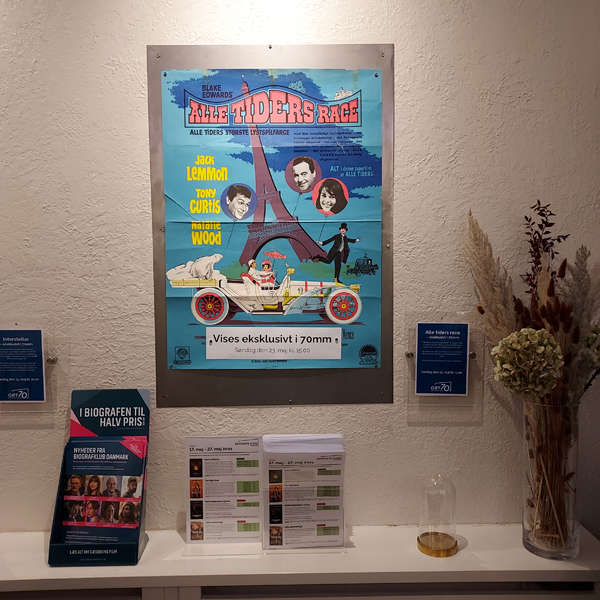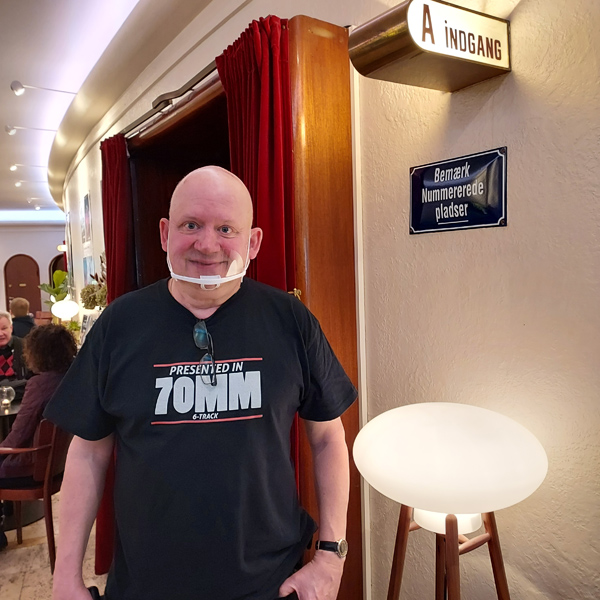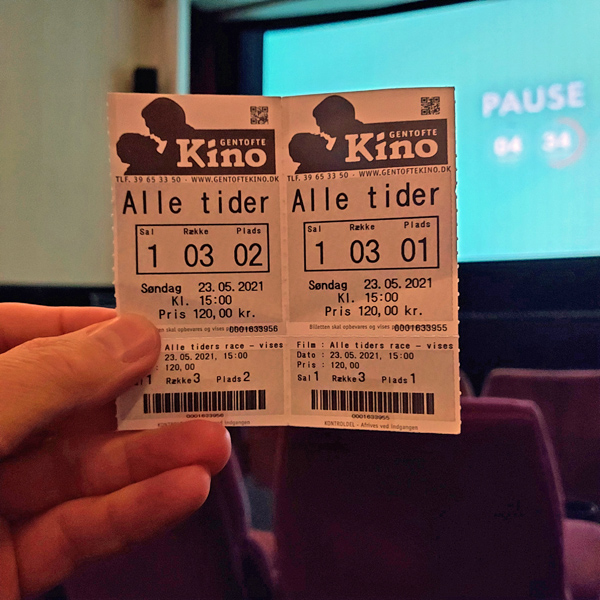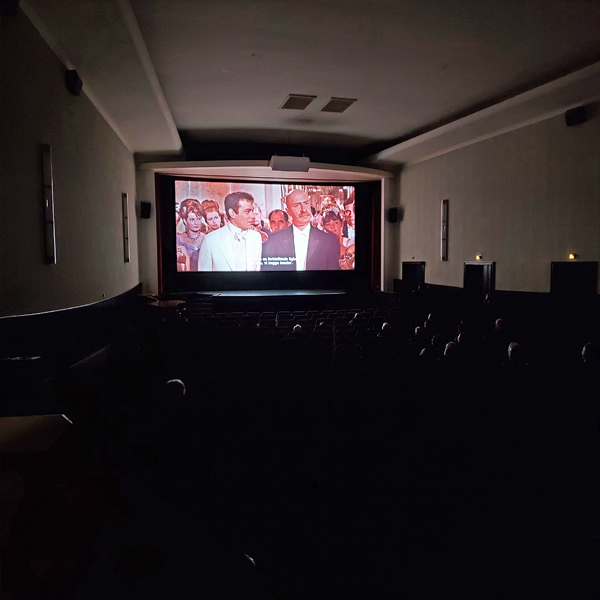The Greatest 70mm Race |
Read more at in70mm.com The 70mm Newsletter |
| Written and photographed by: Thomas Hauerslev | Date: 27.05.2021 |
 Danish
movie poster for "The Great Race", 1966. Very tastefully displayed at the
Kino. No expense spared to make GIFF 70 an event to please the audience. Danish
movie poster for "The Great Race", 1966. Very tastefully displayed at the
Kino. No expense spared to make GIFF 70 an event to please the audience.Any rumours about the death of 70mm are greatly exaggerated! The first 70mm festival at the Gentofte Kino (about 7 km north of central Copenhagen, DK) ended yesterday evening [23. May '21] with a screening of Blake Edwards' classic “The Great Race” (1965). An original 70mm premiere print from the first release in 1966. "The Great Race" bookended Gentofte International 70mm Film Festival [GIFF 70], after 2½ days of 70mm at Gentofte Kino in Denmark. Thanks to the ambitions of Sune Thomsen the Kino's manager, it is close to a miracle to be able to see 70mm again in a cinema like the Kino. GIFF 70 is focuses exclusively on the majestic and legendary 7OMM format, and is intended to be an annual festival in January. Because of pandemic restrictions, the 2021 festival was moved to May 21-23, 2021. Sune Lind Thomsen, manager of Gentofte Kino describes GIFF 70 like this.
The festival began Friday evening with Quentin Tarantino's
"The Hateful Eight" (2015). It continued Saturday with
"Dunkirk" (2017)
by Christopher Nolan, then “Out of Africa” (1985) by Sidney Pollack and
"Joker" (2019), Todd Phillips,
and continued Sunday with a morning screening of the popular
"Interstellar" (2014)
also by Christopher Nolan.
The Kino had been "dressed" for 70mm several weeks in advance. Ticket
sales started in late April once the final dates were settled. Facebook was
used to promote the event with weekly updates about posters, prints and
projector. Original Danish posters were on display in the foyer, a four page A4 color flyer
was available in the boxoffice and a full-page advert in the newspapers a
week in advance.
I attended "The
Hateful Eight" and "The Great Race". |
More in 70mm reading: GIFF 70, Copenhagen, Denmark PDF: GIFF 70 Program flyer Gallery Gentofte Kino Sune L Thomsen about GIFF 7O @ the Gentofte Kino, Denmark Meet the Chief - Jan Niebuhr “The Great Race”: The 70mm Engagements "Joker" Production Notes "Interstellar" Goes IMAX 70MM and 5/70 MM Quentin Tarantino's "The Hateful Eight" in Ultra Panavision 70 "Dunkirk" filmed in 65mm with IMAX cameras Ultra Panavision 70 - Adjustment and modifications Super Technirama 70 Todd-AO Google maps: Gentofte Kino location |
 Projectionist
Jan Niebuhr who is properly dressed for the 70mm film festival, is welcoming the
audience. Projectionist
Jan Niebuhr who is properly dressed for the 70mm film festival, is welcoming the
audience.The GIFF 70 kicked off Friday evening with a 70mm screening of "The Hateful Eight" in blazing Ultra Panavision 70 with almost 90 tickets being sold. While respecting Covid distance rules, the audience seemed to enjoy the show. Projectionist Jan Niebuhr was in the door checking the tickets. The auditorium was buzzing quietly with anticipation. Fans of 70mm and audience alike were taking their seats. Young David Brynskov and his dad Martin drove all the way from Aarhus to see 70mm again. Their previous 70mm adventures include both Krnov and Karlsruhe. The manager of the Kino introduced the show from the stage in front of the screen by welcoming the audience and telling them anecdotes about the special anamorphic projection lens. Overture began, and slowly the light was dimmed. The bordeaux curtains majestically opened revealing the screen, and the CINERAMA logo, the artists respectful nod to the roadshow era. Morricone's music and the main titles played well, and on the adventure we went. Occasionally annoying white flashes were visible at the bottom of the screen. The masking plate is too big it seems. Around two hours into the show, the Intermission came up. 20 minutes to refresh yourself with drinks and sweets from the bar (in the cinema) and box-office in the foyer. Picture quality of "H8" was sadly a bit of a let-down compared to previous 70mm screenings which my wife and I attended. I kept my mouth shut on the way home in the car, but was surprised by the remarks from my own family. The Ultra Panavision 70 presentation itself had been a bit flawed by projection optics that didn't quite live up to modern standards it seems. The image was lacking in contrast and sharpness. It was not the "larger than life" sharpness you would normally expect from 70mm. |
|
 "The
Great Race" (Titled "Alle Tiders Race" in
Danish), the film originally
opened as a Cinerama presentation at the Kinopalæet 9. June 1966, and played
2½ months. "The
Great Race" (Titled "Alle Tiders Race" in
Danish), the film originally
opened as a Cinerama presentation at the Kinopalæet 9. June 1966, and played
2½ months.Another objection were the digitally projected subtitles. Normally - in the old days - subtitles were engraved in 70mm prints by Titra in Bruxelles (BE). Very small white letters which made them easy to read. As the letters were the same size as 35mm subtitles they looked approximately 20% smaller in 70mm, thus making the 70mm picture look bigger on a same-size screen. That process is now obsolete, however, and today subtitles are projected digitally in synch with the 70mm projector. It makes sense, and it is probably cheaper. The digital subtitles used at the Kino are not my favorite, however. They are very large, feels like a distraction and removes the grandeur of 70mm. They also look a bit "off", being yellow. Besides that, they are also difficult to read. The width of a simple sentence like "og du ligger død bag mig, John" fills a third of the screen width! You have to move your head too much to read. A sentence like this should only fill about a quarter of the screen width in my opinion. On top of that, the digital projector also spills a haze of white light on the screen where the subtitles are, and thereby washing out the contrast. There must be a better way to do this. It can be done in Krnov, Karlsruhe and elsewhere, so why not in Gentofte Kino? It's seems to be a waste of effort to invest in 70mm projection and organize a 70mm festival, and then use a less-than-satisfactory subtitling system which additionally degrades picture quality. Several issues for the to-do-list to be solved before the next 70mm presentation. According the Kino's Facebook page the Saturday went ahead very well, with "Out of Africa" selling the most tickets of the day. Friends of the Kino are expressing their gratitude of the service and dedication, and look forward to next year's event. The Kino was built before the introduction of wide screen systems like CinemaScope and Todd-AO. Dating back to 1938 and designed for the 1,37.1 Academy ratio, the Kino was of course rebuilt later for CinemaScope. The curved screen is around 12 meters wide, and the throw is 35 meters. Three times the width of the screen. Some would argue the Kino is not particularly well suited for 70mm. Converting an older existing cinema to 70mm is not a new idea. This happened to a lot of Danish cinemas during the '60s. In fact around half of the approximately 70 Danish 70mm installations were retrofit installations like the Kino. Suited or not, simply sit closer to the screen as we did - on the third row. 70mm works well too from the back of the cinema producing a super sharp picture with plenty of light. The Kino had premiered their new 70mm installation in August 2020 with "Tenet" in authentic 70mm. Sune is to be applauded for the efforts to show 70mm at the Kino, giving the audience a rare opportunity to see real film in a cinema. Not only that, but 7OMM! |
|
 The
Kino looks great dressed for 70mm from the back row. Note the small and
pleasing "analogue" neutral looking engraved subtitles from a vintage 70mm
print. The
Kino looks great dressed for 70mm from the back row. Note the small and
pleasing "analogue" neutral looking engraved subtitles from a vintage 70mm
print.Sunday afternoon my daughter Maria and I took our seats on the third row. Again Jan Niebuhr was in the door to check the tickets. I wanted to go upstairs and say hello to the projectionists Alan and Orla, but the door was locked, and Sune did not want visitors 15 min before the show. David and Martin Brynskov were already seated, as was the former Kino manger Erik Hamre, and Morten "Mr Dancan" Jacobsen who has also been a guest in Karlsruhe. Behind us were Per Tofte Nielsen, projectionist at the Danish Cinematek and director Simon Wasiolek ("Diamantpigen"). It was a very mature audience, who probably have seen the film before. Sune introduced the show, but did not bother to go on stage with a microphone. A little festival fatigue perhaps? Titled "Alle Tiders Race" in Denmark, the film originally opened as a Cinerama presentation at the Kinopalæet 9. June 1966, and played until 21. August 1966. Originally, the Super Technirama 70 short film "Shellarama" was shown before the main feature. "Race" was re-released a few times, including an encore one-week 70mm run at the 3 Falke Bio Todd-AO theatre from 23. July 1980 until 29. July 1980. This screening was the first public screening in 40+ years in Copenhagen. The print played well, and still has some color left, but not much. Of course a 70mm print being of this vintage, is to be expected to have some color fading, and not up to current standards. Overall, still a very pleasing Panavision 70 look, and the missing colors really did not matter. What counted was being present to experience this. The vertical masking was a bit too open for the first half of the film. Per mentioned this to the staff during the intermission, and for the second half the masking was spot on. "The Great Race" is a very funny film with superb performances by Jack Lemmon, Natalie Wood, Peter Falk and Tony Curtis, and a marvellous score by Henry Mancini, with wonderful sets and photography throughout. It was the most expensive comedy ever made when it came out in 1965. They really do not make them like this any more. Dedicated to Laurel and Hardy, it is superb entertainment, and we both laughed at the hysterical dialogue, the pie fight and all the gags. What "Race" lacked in color, however, was gained as the most fun film of the weekend, and the production which got the most laughs from the audience. 2 hours and 40 min of pure slapstick. It was the least successful of the six films this weekend perhaps (in terms of the number of tickets sold), but by far the most rewarding for me, and those of us who were there. A very sharp image on the screen, very good light and impressive sound from the old mag tracks. It was truly a rare experience to see this on the big screen and a testament to Sune's dedication to present the authentic cinema experience. He is to be applauded for the efforts to bring back the classic 70mm format, and I hope the local community will support and appreciate it in the years to come. It is a huge effort to organize a festival like this. An absolute endless check-list of things to do. Despite the few issues for the to-do-list, and some beginners bugs mentioned here, it seems GIFF 70 got off with a good start. The Greatest Show in Todd-AO! I hope the GIFF 70 is here to stay, and we all look forward to the next festival in 2022. |
|
| Go: back - top - back issues - news index Updated 22-01-25 |
